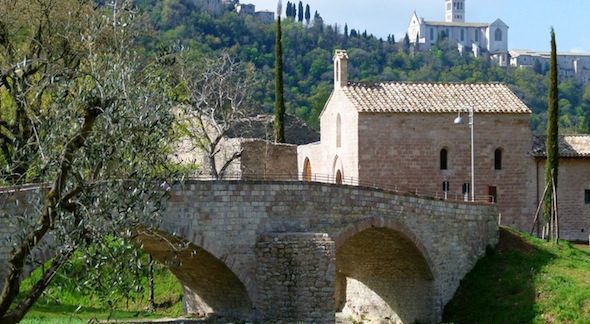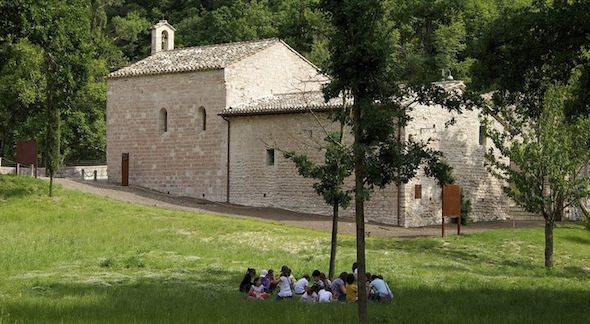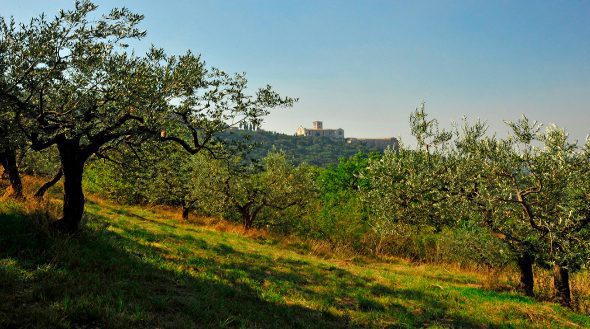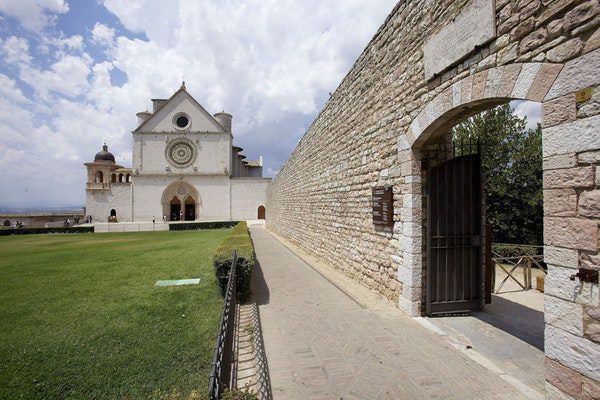Il Bosco di San Francesco è patrimonio del FAI – Fondo Ambientale Italiano e si trova proprio ai piedi della grandiosa Basilica di San Francesco, accanto al centro storico di Assisi.
Si tratta di uno splendido esempio di paesaggio rurale italiano, un’area incontaminata di 64 ettari e oltre 800 anni di storia, che attraversa terreni boschivi e radure, campi coltivati e oliveti. Passeggiare e addentrarsi in questo bosco è qualcosa in più di una semplice escursione, è una vera e propria immersione nell’armonia e nel silenzio, nell’autenticità più vera e spirituale dell’Umbria.
Durante la visita ad Assisi, non può mancare un cammino nel Bosco di San Francesco per completare un’esperienza spirituale intensa e unica.
Entrare nel Bosco di San Francesco

L’ingresso al Bosco di San Francesco è nel cuore di Assisi, proprio accanto alla Basilica di San Francesco. E’ necessario infatti attraversare il portone situato nel muro di cinta di piazza San Francesco, davanti all’omonima basilica. Percorrendo lo stretto sentiero che scende lungo il fondovalle, ci si addentra pian piano in questo magnifico regno naturale e spirituale.
Entrati nel Bosco di San Francesco, la cui prima porzione appartiene ai frati francescani, osservate i muri di cinta che in parte rimangono alle vostre spalle e in parte circondano ancora il paesaggio forestale. Questo tratto di cinta muraria è una sezione del lungo perimetro delle mura urbane erette in epoca romana, tra i II e il I secolo a.C., e poi ampliate tra il XIII e il XIV secolo per far fronte all’aumento demografico cittadino.
Procedendo lungo il percorso del Bosco e superando la parte più prettamente forestale, lasciatevi sulla sinistra il Ponte dei Galli. Proseguendo il cammino verso fondovalle, è possibile scorgere sulla pianura i profili di alcuni edifici. Si tratta dei resti di un articolato sistema architettonico di natura religiosa e rurale, comprendente in origine un ospedale, un monastero e una chiesa benedettini e, nelle adiacenze, un mulino di pertinenza conventuale.
Il Cammino nel Bosco di San Francesco fino al Centro Visitatori

Una passerella in legno attraversa i resti delle mura originarie; una volta superata si accede all’area dell’antico Hospitalis Pontis Gallorum (Ospedale del Ponte dei Galli), di cui sopravvive parte del recinto esterno in pietra calcarea del Subasio sul lato lungo a est e sull’adiacente lato a sud. Sono tuttora visibili inoltre un’apertura vicino alla facciata della chiesa, tracce di possibili contrafforti e alcune nicchie collocate a diversi altezze, la cui funzione non è ancora stata identificata.
Dalle analisi delle tracce murarie, parzialmente interrate, non sono emersi punti di contatto coerenti con la muratura esterna ed è quindi molto probabile che quest’ultima fosse separata dagli edifici presenti all’interno del perimetro. Attivo già nel 1250 e fino alla seconda metà del Trecento, l’ospedale passò, all’incirca con il cambio di secolo, dalla gestione di frati a quella di monache benedettine, entrambi comunque subordinati all’autorità vescovile.
Proseguendo nel percorso si passa poi per il Centro Visitatori del Bosco di San Francesco, realizzato dal FAI all’interno della canonica benedettina. Dal centro visitatori del FAI si può quindi accedere alla piccola Chiesa di Santa Croce, originaria della metà del XIII secolo e modificata in seguito, nel corso del Seicento. Santa Croce può essere ascritta alle cosiddette “cappelle”, luoghi di culto di dimensioni molto ridotte, con ruolo minore rispetto alle pievi, destinate a comunità di campagna.

Puoi inoltre approfondire i luoghi simbolo e gli itinerari consigliati ad Assisi nel nostro articolo su Cosa Vedere ad Assisi in un giorno
Just next the magnificent Basilica of St. Francis, you can visit also Bosco di San Francesco (St. Francis’ Wood), an amazing example of Italian rural landscape of 64 acres and over 800 years of history running through woodland and cultivated fields , olive groves and glades .
You enter Bosco di San Francesco through a door located in the wall in front of the Basilica. Once in the Forest – the first part belongs to the Franciscan friars – take a look at the walls, which is a long section of the perimeter of the city walls built in Roman times, in the second/ first century BC, and expanded in XIII / XIV century to cope with the increasing population of Assisi.
Proceeding along the path of the Wood you will leave the bridge of the Gauls on the left. Continuing the journey towards the valley floor, you can see the plain profiles of some buildings. These are the remains of a complex architectural system of religious and rural nature in origin including a hospital, a Benedictine monastery and a church, and adjacent a mill belonging to the convent .
>> Do you want to visit Assisi? Check it out now of the best hotels in Assisi Italy
![]()
>> Do you want to discover Assisi’s treasures? Check it out now of the best farmhouses in Assisi.
A wooden walkway through the remains of the original walls , once exceeded is the gateway to the ancient Hospitalis Pontis Gallorum ( Hospital del Ponte dei Galli ), of which survives part of the outer limestone Subasio on the long side of the east and on the adjacent side to the south. Traces of possible niches and buttresses whose function has not yet been identified are still visible. From the analysis of the traces walls, partially buried, there were no points of contact consistent with the outer wall and is therefore very likely that the latter was separated from the buildings inside the perimeter. Active since 1250 and until the second half of the fourteenth century , the hospital passed , around the turn of the century, from the management of the friars to that of the Benedictine nuns, both still under the bishop authority.
If you continue the path you will arrive to the Bosco di San Francesco’s Visitor Center, created by the FAI within the canonical Benedictine . From here you can access the small Church of Santa Croce, originally from the mid-thirteenth century and later changed, during the seventeenth century . Holy Cross can be ascribed to the so-called ” chapels ” , places of worship very small , with a minor role compared to the churches, destined to communities in the country.
If you’ve decided to visit Assisi and discover St. Francis’ Wood you should contact now farmhouses near Assisi >> click this link.
Just next the magnificent Basilica of St. Francis, you can visit also Bosco di San Francesco (St. Francis’ Wood), an amazing example of Italian rural landscape of 64 acres and over 800 years of history running through woodland and cultivated fields , olive groves and glades .
You enter Bosco di San Francesco through a door located in the wall in front of the Basilica. Once in the Forest – the first part belongs to the Franciscan friars – take a look at the walls, which is a long section of the perimeter of the city walls built in Roman times, in the second/ first century BC, and expanded in XIII / XIV century to cope with the increasing population of Assisi.
Proceeding along the path of the Wood you will leave the bridge of the Gauls on the left. Continuing the journey towards the valley floor, you can see the plain profiles of some buildings. These are the remains of a complex architectural system of religious and rural nature in origin including a hospital, a Benedictine monastery and a church, and adjacent a mill belonging to the convent .
>> Do you want to visit Assisi? Check it out now of the best hotels in Assisi Italy
![]()
>> Do you want to discover Assisi’s treasures? Check it out now of the best farmhouses in Assisi.
A wooden walkway through the remains of the original walls , once exceeded is the gateway to the ancient Hospitalis Pontis Gallorum ( Hospital del Ponte dei Galli ), of which survives part of the outer limestone Subasio on the long side of the east and on the adjacent side to the south. Traces of possible niches and buttresses whose function has not yet been identified are still visible. From the analysis of the traces walls, partially buried, there were no points of contact consistent with the outer wall and is therefore very likely that the latter was separated from the buildings inside the perimeter. Active since 1250 and until the second half of the fourteenth century , the hospital passed , around the turn of the century, from the management of the friars to that of the Benedictine nuns, both still under the bishop authority.
If you continue the path you will arrive to the Bosco di San Francesco’s Visitor Center, created by the FAI within the canonical Benedictine . From here you can access the small Church of Santa Croce, originally from the mid-thirteenth century and later changed, during the seventeenth century . Holy Cross can be ascribed to the so-called ” chapels ” , places of worship very small , with a minor role compared to the churches, destined to communities in the country.
If you’ve decided to visit Assisi and discover St. Francis’ Wood you should contact now farmhouses near Assisi >> click this link.
Just next the magnificent Basilica of St. Francis, you can visit also Bosco di San Francesco (St. Francis’ Wood), an amazing example of Italian rural landscape of 64 acres and over 800 years of history running through woodland and cultivated fields , olive groves and glades .
You enter Bosco di San Francesco through a door located in the wall in front of the Basilica. Once in the Forest – the first part belongs to the Franciscan friars – take a look at the walls, which is a long section of the perimeter of the city walls built in Roman times, in the second/ first century BC, and expanded in XIII / XIV century to cope with the increasing population of Assisi.
Proceeding along the path of the Wood you will leave the bridge of the Gauls on the left. Continuing the journey towards the valley floor, you can see the plain profiles of some buildings. These are the remains of a complex architectural system of religious and rural nature in origin including a hospital, a Benedictine monastery and a church, and adjacent a mill belonging to the convent .
>> Do you want to visit Assisi? Check it out now of the best hotels in Assisi Italy
![]()
>> Do you want to discover Assisi’s treasures? Check it out now of the best farmhouses in Assisi.
A wooden walkway through the remains of the original walls , once exceeded is the gateway to the ancient Hospitalis Pontis Gallorum ( Hospital del Ponte dei Galli ), of which survives part of the outer limestone Subasio on the long side of the east and on the adjacent side to the south. Traces of possible niches and buttresses whose function has not yet been identified are still visible. From the analysis of the traces walls, partially buried, there were no points of contact consistent with the outer wall and is therefore very likely that the latter was separated from the buildings inside the perimeter. Active since 1250 and until the second half of the fourteenth century , the hospital passed , around the turn of the century, from the management of the friars to that of the Benedictine nuns, both still under the bishop authority.
If you continue the path you will arrive to the Bosco di San Francesco’s Visitor Center, created by the FAI within the canonical Benedictine . From here you can access the small Church of Santa Croce, originally from the mid-thirteenth century and later changed, during the seventeenth century . Holy Cross can be ascribed to the so-called ” chapels ” , places of worship very small , with a minor role compared to the churches, destined to communities in the country.
If you’ve decided to visit Assisi and discover St. Francis’ Wood you should contact now farmhouses near Assisi >> click this link.
Just next the magnificent Basilica of St. Francis, you can visit also Bosco di San Francesco (St. Francis’ Wood), an amazing example of Italian rural landscape of 64 acres and over 800 years of history running through woodland and cultivated fields , olive groves and glades .
You enter Bosco di San Francesco through a door located in the wall in front of the Basilica. Once in the Forest – the first part belongs to the Franciscan friars – take a look at the walls, which is a long section of the perimeter of the city walls built in Roman times, in the second/ first century BC, and expanded in XIII / XIV century to cope with the increasing population of Assisi.
Proceeding along the path of the Wood you will leave the bridge of the Gauls on the left. Continuing the journey towards the valley floor, you can see the plain profiles of some buildings. These are the remains of a complex architectural system of religious and rural nature in origin including a hospital, a Benedictine monastery and a church, and adjacent a mill belonging to the convent .
>> Do you want to visit Assisi? Check it out now of the best hotels in Assisi Italy
![]()
>> Do you want to discover Assisi’s treasures? Check it out now of the best farmhouses in Assisi.
A wooden walkway through the remains of the original walls , once exceeded is the gateway to the ancient Hospitalis Pontis Gallorum ( Hospital del Ponte dei Galli ), of which survives part of the outer limestone Subasio on the long side of the east and on the adjacent side to the south. Traces of possible niches and buttresses whose function has not yet been identified are still visible. From the analysis of the traces walls, partially buried, there were no points of contact consistent with the outer wall and is therefore very likely that the latter was separated from the buildings inside the perimeter. Active since 1250 and until the second half of the fourteenth century , the hospital passed , around the turn of the century, from the management of the friars to that of the Benedictine nuns, both still under the bishop authority.
If you continue the path you will arrive to the Bosco di San Francesco’s Visitor Center, created by the FAI within the canonical Benedictine . From here you can access the small Church of Santa Croce, originally from the mid-thirteenth century and later changed, during the seventeenth century . Holy Cross can be ascribed to the so-called ” chapels ” , places of worship very small , with a minor role compared to the churches, destined to communities in the country.
If you’ve decided to visit Assisi and discover St. Francis’ Wood you should contact now farmhouses near Assisi >> click this link.






Comment (0)